|
Rapid Comprehensive MRI
Combined Educational & Scientific Session
ORGANIZERS: Michael Lustig, Demian Wassermann
Monday, 18 June 2018
| S01 |
08:15 - 10:15 |
Moderators: Oliver Bieri, Christiane Kuhl |
Skill Level: Basic to Intermediate
Session Number: M-03
Overview
This session will be focused on technology and clinical needs for rapid comprehensive MRI exams. This include multi-contrast sequences, synthetic MR, and accelerated parameter mapping. It will have two educational speakers: 1) A speaker providing the big-picture clinical need for comprehensive, rapid examinations as well as their quantitative/qualitative assessment; 2) A speaker who will give an overview on the technical trends and current state-of-the-art techniques for rapid comprehensive exams and the type of information these methods provide.
Target Audience
ISMRM attendees looking to learn the current state of the art of rapid comprehensive exams, multi-contrast sequences, synthetic M, and parameter mapping.
Educational Objectives
As a result of attending this course, participants should be able to:
-Name the classes of techniques used for comprehensive exam and differentiate the types of information they provide;
-Identify the methodologies in which comprehensive information can be rapidly collected; and
-Recognize the clinical need for comprehensive exams and how these exams can be used in practice.
08:15
|
|
 Clinical Needs Clinical Needs
Vikas Gulani
|
08:45
|
|
 Technical Trends Technical Trends
Julia Velikina
|
09:15
|
0031.
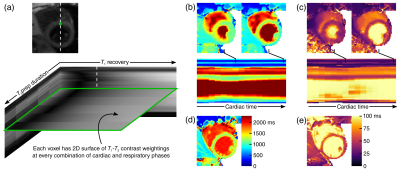 |
 Non-ECG, free-breathing myocardial T1-T2 mapping of acute myocardial infarction using low-rank tensor MR multitasking Non-ECG, free-breathing myocardial T1-T2 mapping of acute myocardial infarction using low-rank tensor MR multitasking
Anthony Christodoulou, Jaime Shaw, Christopher Nguyen, Yibin Xie, Nan Wang, Qi Yang, Debiao Li
Myocardial tissue characterization by T1-T2 mapping is promising for diagnosing myocardial infarction, ischemia, and more. This is typically performed using ECG triggering and breath-holding, which is uncomfortable and unreliable in patients. This work describes a novel method for non-ECG free-breathing joint T1-T2 mapping using cardiovascular MR multitasking, modeling the underlying 6D multidimensional image—which has 2 spatial dimensions + 4 time dimensions (cardiac, respiratory, T1, and T2)—as a low-rank tensor. T1 and T2 measurements in acute myocardial infarction patients agreed with reference methods and predicted late gadolinium enhancement with 100% sensitivity and 92% specificity.
|
09:27
 |
0032.
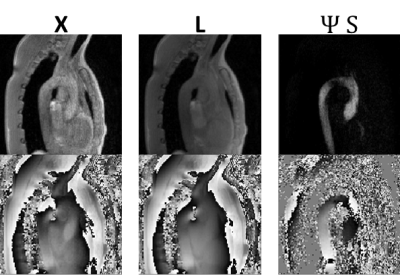 |
 5D Flow MRI – Respiratory Motion Resolved Accelerated 4D Flow Imaging Using Low-Rank + Sparse Reconstruction 5D Flow MRI – Respiratory Motion Resolved Accelerated 4D Flow Imaging Using Low-Rank + Sparse Reconstruction
Jonas Walheim, Sebastian Kozerke
We present a low-rank + sparse reconstruction method which resolves respiratory motion in 4D flow magnetic resonance imaging as a low-rank signal component. Respiratory motion resolved 4D flow MRI data is reconstructed and compared to the total variation based XD-GRASP method and a standard parallel imaging acquisition protocol. Good agreement of the reconstructed results with the reference shows that a low-rank model is effective in resolving respiratory motion in 4D flow magnetic resonance imaging.
|
09:39
|
0033.
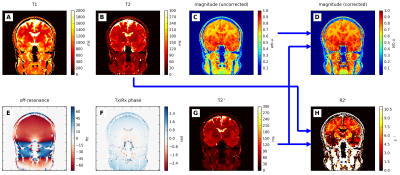 |
Multi-echo Magnetic Resonance Fingerprinting: Simultaneous derivation of T1, T2, B0, T2*, T2', Tx/Rx phase maps, and T2*-corrected magnitude maps in in-vivo and phantom studies
Video Permission Withheld
Thomas Amthor, Jakob Meineke, Karsten Sommer, Peter Koken, Mariya Doneva
This work describes a Magnetic Resonance Fingerprinting (MRF) implementation using multiple echo acquisitions within one TR. In this way, B0, T2*, R2', and Tx/Rx phase maps are derived in addition to the standard M0, T1, and T2 maps, as demonstrated in in-vivo and phantom experiments. Accounting for the difference in T2 and T2*, the inherent bias of MRF-derived M0 maps can be corrected. The derived R2' map may have diagnostic relevance for neurodegenerative diseases.
|
09:51
|
0034.
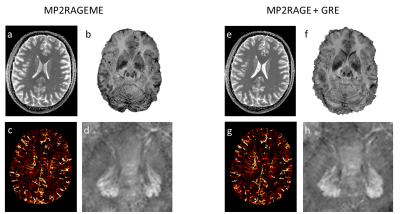 |
 MP2RAGEME: T1, T2* and QSM mapping in one sequence at 7 Tesla MP2RAGEME: T1, T2* and QSM mapping in one sequence at 7 Tesla
Matthan Caan, Pierre-Louis Bazin, Alessio Fracasso, Josť Marques, Serge Dumoulin, Wietske van der Zwaag
Quantitative T1, T2* and QSM information can be acquired in a single acquisition, using a multi-echo extension of the MP2RAGE sequence, MP2RAGEME. This simultaneous acquisition results in large time savings, perfectly coregistered data and minimal image quality differences. Following a correction for residual transmit B1-sensitivity quantitative T1 and T2* and QSM-values were in excellent agreement with those obtained from separately acquired MP2RAGE and GRE data. Values were also in correspondence with literature. From the MP2RAGEME data, a multiparametric cortical parcellation was obtained, as well as a combined arterial and venous map.
|
10:03
|
0035.
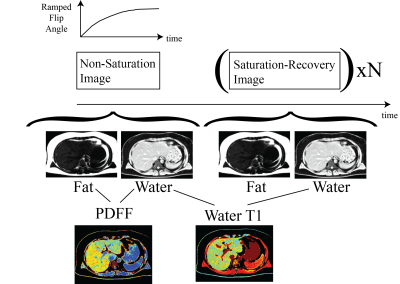 |
 Simultaneous Proton Density Fat Fraction Imaging and Water T1-Mapping with Low B1+ Sensitivity (PDFF-T1) Simultaneous Proton Density Fat Fraction Imaging and Water T1-Mapping with Low B1+ Sensitivity (PDFF-T1)
Richard Thompson, Kelvin Chow, Justin Grenier
Quantitative multi-parametric MR imaging is an important component of diagnosis and objective staging of diffuse liver disease, reducing the need for biopsy. The goal of the current study was to validate a new simultaneous proton density fat fraction and water T1-mapping approach (PDFF-T1) with low B1+ sensitivity in a short, patient-friendly breath-hold acquisition. It is shown (simulations, phantoms, in-vivo) that a time-varying flip angle excitation scheme leads to improved accuracy of PDFF and that fat-water separation enables water-specific T1 mapping, all in a single patient-friendly breath-hold, with low sensitivity to inhomogeneity in the transmitted radiofrequency (B1+) field.
|
10:15
|
|
Adjournment & Meet the Teachers |
|







